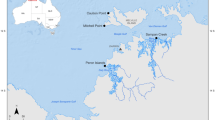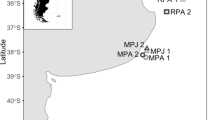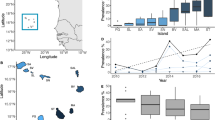Abstract
The main commercial fish species in the Irminger Sea, the beaked redfish Sebastes mentella, is commonly infected with the copepod Sphyrion lumpi. This ectoparasite is often used as a biological marker for stock discrimination to evaluate the still-debated metapopulation structure of beaked redfish. Nevertheless, it is still not understood whether parasite abundances and communities vary over longer time periods. In the present study, we investigated the abundance of S. lumpi in S. mentella of the pelagic zone of the Irminger Sea and adjacent waters. Our analyses revealed that live S. lumpi abundance remained constant during summer over a sampling period from 2001 to 2015, which confirms its validity as a biomarker. As S. mentella forms dense aggregations during mating, our results suggest that host densities are, regardless of a fishery-induced decrease in host biomass, large enough to facilitate the direct transmission of S. lumpi. After correcting for covariate effects, two stock units could be differentiated, which supports a continuation of the current fishery management strategy.





Similar content being viewed by others
References
Akaike H (1987) Factor analysis and AIC. Psychometrika 52:317–332
Arai M (2011) Cluster-robust standard errors using R. Technical report Stockholm University
Bakay YI (1988) Applications of results from parasitological investigations in redfish (Sebastes mentella Travin) populational structure studies. ICES CM 1988/G:35:14 pp
Bakay YI (2011) Ecological and parasitological characteristics of redfish Sebastes mentella (Scorpaeniformes: Sebastidae) from the Norwegian Sea and adjacent waters. J Ichthyol 51:90–97
Bakay YI (2015) Pigment spots on the skin as a phene of the North Atlantic population of the beaked redfish, Sebastes mentella Travin, 1951 (Scorpaenidae). Russ J Mar Biol 41:136–139
Bakay YI, Melnikov SP (2008) Biological and ecological characteristics of deepwater redfish Sebastes mentella (Scorpaenidae) at different depths in the pelagial of the Irminger Sea. J Ichthyol 48:68–80
Begg GA, Friedland KD, Pearce JB (1999) Stock identification and its role in stock assessment and fisheries management: an overview. Fish Res 43:1–8
Boxshall GA (1998) Host specificity in copepod parasites of deep-sea fishes. J Mar Syst 15:215–223
Boxshall GA (2005) Copepoda (copepods). Mar Parasitol CSIRO Publ Melb CABI Wallingford Oxon, pp 123–138
Brooks DR, Hoberg EP (2007) How will global climate change affect parasite–host assemblages? Trends Parasitol 23:571–574
Buchmann K, Kania P (2012) Emerging Pseudoterranova decipiens (Krabbe, 1878) problems in Baltic cod, Gadus morhua L., associated with grey seal colonization of spawning grounds. J Fish Dis 35:861–866
Bush AO, Lafferty KD, Lotz JM, Shostak AW (1997) Parasitology meets ecology on its own terms: Margolis et al. revisited. J Parasitol 575–583
Cadrin SX, Bernreuther M, Daníelsdóttir AK et al (2010) Population structure of beaked redfish, Sebastes mentella: evidence of divergence associated with different habitats. ICES J Mar Sci J Cons 67:1617–1630
Cadrin SX, Mariani S, Pampoulie C et al (2011) Counter-comment on: Cadrin et al. (2010) “population structure of beaked redfish, Sebastes mentella: evidence of divergence associated with different habitats. ICES journal of marine science, 67: 1617–1630.”. ICES J Mar Sci J Cons 68:2016–2018
Campbell N, Cross MA, Chubb JC et al (2007) Spatial and temporal variations in parasite prevalence and infracommunity structure in herring (Clupea harengus L.) caught to the west of the British Isles and in the North and Baltic Seas: implications for fisheries science. J Helminthol 81:137–146
Dobson AP, Lafferty KD, Kuris AM et al (2008) Homage to Linnaeus: how many parasites? How many hosts? Proc Natl Acad Sci 105:11482–11489
Dojiri M, Deets GB (1988) Norkus cladocephalus, new genus, new species (Siphonostomatoida: Sphyriidae), a copepod parasitic on an elasmobranch from Southern California waters, with a phylogenetic analysis of the Sphyriidae. J Crustac Biol 8:679–687
Gaevskaya AV (1984) The copepod Sphyrion lumpi (Krøyer) as a biological indicator in population studies of redfish (in Russian). In: Batalyants KY (ed) Nutrition and differentiation of marine commercial fish and invertebrates. Atlant NIRO, Kaliningrad, pp 90–99
Herrington WC (1939) Observations on the life history, occurrence, and distribution of the redfish parasite Sphyrion lumpi. United States Bureau of Fisheries Special Report No. 5
Hilbe JM (2011) Negative binomial regression. Cambridge University Press, Cambridge
Hudson PJ, Dobson AP, Lafferty KD (2006) Is a healthy ecosystem one that is rich in parasites? Trends Ecol Evol 21:381–385
ICES (2015a) ICES advice on fishing opportunities, catch and effort Iceland Sea and Oceanic Northeast Atlantic ecoregions. Copenhagen, Denmark, 14 pp
ICES (2015b) Report of the North-Western Working Group (NWWG), 28 April–5 May, 2015. ICES Headquarters, Copenhagen, Denmark
ICES (2015c) Manual for the International Deep Pelagic Ecosystem Survey in the Irminger Sea and Adjacent Waters. In: Series of ICES Survey Protocols SISP 11- IDEEPS VI. Copenhagen, Denmark, 49 pp
ICES (2015d) Third Interim Report of the Working Group on International Deep Pelagic Ecosystem Surveys (WGIDEEPS), 4–6 August 2015. Marine Research Institute, Reykjavík (Iceland)
ICES (2016) Report of the North-Western Working Group (NWWG), 27 April −4 May 201. Headquarters, Copenhagen/Denmark. ICES CM 2016/ACOM:08
ICES C (2009) Report of the workshop on redfish stock structure (WKREDS)
Kabata Z (1979) Parasitic Copepoda of British fishes. Ray Society, London
Karl H, Kammann U, Aust M-O et al (2016) Large scale distribution of dioxins, PCBs, heavy metals, PAH-metabolites and radionuclides in cod (Gadus morhua) from the North Atlantic and its adjacent seas. Chemosphere 149:294–303
Kosswig K (1977) Zur Biologie des pelagischen Rotbarschbestandes in der Irminger See. Informationen Für Fischwirtsch ISSN 0020–0344:204–208
MacKenzie K (2002) Parasites as biological tags in population studies of marine organisms: an update. Parasitology 124:153–163
MacKenzie K, Abaunza P (1998) Parasites as biological tags for stock discrimination of marine fish: a guide to procedures and methods. Fish Res 38:45–56
MacKenzie K, Abaunza P (2014) Parasites as biological tags. In: Cadrin SX, Friedland KD, Waldman JR (eds) Stock identification methods. Elsevier, NY, pp 211–226
MacKenzie K, Campbell N, Mattiucci S et al (2008) Parasites as biological tags for stock identification of Atlantic horse mackerel Trachurus trachurus L. Fish Res 89:136–145
Magnússon JV (1992) Notes on the infestation by Sphyrion lumpi and abnormalities in the pigmentation of the oceanic Sebastes mentella. ICES CM 1992/G:52:9
Magnússon J (1996) The deep scattering layers in the Irminger Sea. J Fish Biol 49:182–191
Magnússon J, Magnússon JM (1995) Oceanic redfish (Sebastes mentella) in the Irminger Sea and adjacent waters. Sci Mar 59:241–254
Makhrov AA, Artamonova VS, Popov VI et al (2011) Comment on: Cadrin et al. (2010) “Population structure of beaked redfish, Sebastes mentella: evidence of divergence associated with different habitats. ICES journal of marine science, 67: 1617–1630.”. ICES J Mar Sci J Cons. doi:10.1093/icesjms/fsr132
Marcogliese DJ, Albert E, Gagnon P, Sévigny J-M (2003) Use of parasites in stock identification of the deepwater redfish (Sebastes mentella) in the Northwest Atlantic. Fish Bull-Natl Ocean Atmospheric Adm 101:183–188
Marzoug D, Boutiba Z, Kostadinova A, Pérez-del-Olmo A (2012) Effects of fishing on parasitism in a sparid fish: contrasts between two areas of the western Mediterranean. Parasitol Int 61:414–420
Melnikov SP (2016) Intraspecies structure of beaked redfish Sebastes mentella of the Atlantic and Arctic Oceans. J Ichthyol 56:52–71
Melnikov SP, Bakai YI (2009) Recruitment of stock of deepwater redfish Sebastes mentella (Scorpaeniformes, Scorpaenidae) in the pelagial of the Irminger Sea and adjacent waters. J Ichthyol 49:650
Melnikov SP, Bakay YI (2009) Structure of aggregations and principal populational characteristics of redfish Sebastes mentella (Scorpaeniformes: Scorpaenidae) in the pelagic zone of the Irminger Sea and adjacent waters. J Ichthyol 49:170–182
Melnikov SP, Pedchenko AP, Shibanov VN (2001) Results from the Russian investigations on pelagic redfish (Sebastes mentella, Travin) in the Irminger Sea and in NAFO division 1F. NAFO SCR Doc 1:20
Moran JDW, Piasecki W (1994) External morphology of the male and female of Sphyrion lumpi (Krøyer, 1845) (Copepoda; Siphonostomatoida; Sphyriidae). Hydrobiologia 292/293:171–178
Núñez-Riboni I, Kristinsson K, Bernreuther M et al (2013) Impact of interannual changes of large scale circulation and hydrography on the spatial distribution of beaked redfish (Sebastes mentella) in the Irminger Sea. Deep Sea Res Part Oceanogr Res Pap 82:80–94
Planque B, Kristinsson K, Astakhov A et al (2013) Monitoring beaked redfish (Sebastes mentella) in the North Atlantic, current challenges and future prospects. Aquat Living Resour 26:293–306
Poulin R, Kamiya T (2015) Parasites as biological tags of fish stocks: a meta-analysis of their discriminatory power. Parasitology 142:145–155
Sasal P, Faliex E, Morand S (1996) Parasitism of Gobius bucchichii Steindachner, 1870 (Teleostei, Gobiidae) in protected and unprotected marine environments. J Wildl Dis 32:607–613
Sasal P, Desdevises Y, Durieux E et al (2004) Parasites in marine protected areas: success and specificity of monogeneans. J Fish Biol 64:370–379
Schlitzer R (2009) Ocean data view. Available from: https://odv.awi.de
Shum P, Pampoulie C, Kristinsson K, Mariani S (2015) Three-dimensional post-glacial expansion and diversification of an exploited oceanic fish. Mol Ecol 24:3652–3667
Sigurðsson T, Kristinsson K, Rätz HJ et al (2006) The fishery for pelagic redfish (Sebastes mentella) in the Irminger Sea and adjacent waters. ICES J Mar Sci J Cons 63:725–736
Stefánsson MÖ, Reinert J, Sigurðsson Þ et al (2009) Depth as a potential driver of genetic structure of Sebastes mentella across the North Atlantic Ocean. ICES J Mar Sci J Cons 66:680–690
Templeman W, Squires HJ (1960) Incidence and distribution of infestation by Sphyrion lumpi (Krøyer) on the redfish, Sebastes marinus(L.), of the western North Atlantic. J Fish Board Can 17:9–31
Trella K, Podolska M, Nedreaas K, Janusz J (2013) Discrimination of the redfish (Sebastes mentella) stock components in the Irminger Sea and adjacent waters based on meristics, morphometry and biological characteristics. J Appl Ichthyol 29:341–351
van Banning P, Becker HB (1978) Long-term survey data (1965-1972) on the occurrence of Anisakis larvae (Nematoda: Ascaridida) in herring, Clupea harengus L., from the North Sea. J Fish Biol 12:25–33
Vuong QH (1989) Likelihood ratio tests for model selection and non-nested hypotheses. Econom J Econom Soc 52:307–333
Warton DI (2005) Many zeros does not mean zero inflation: comparing the goodness-of-fit of parametric models to multivariate abundance data. Environmetrics 16:275–289
Welsh AH, Cunningham RB, Donnelly CF, Lindenmayer DB (1996) Modelling the abundance of rare species: statistical models for counts with extra zeros. Ecol Model 88:297–308
Williams IC (1963) The infestation of the redfish Sebastes marinus (L.) and S. mentella Travin (Scleroparei: Scorpaenidae) by the copepods Peniculus clavatus (Müller), Sphyrion lumpi (Krøyer) and Chondracanthopsis nodosus (Müller) in the eastern North Atlantic. Parasitology 53:501–525
Wood CL, Lafferty KD (2015) How have fisheries affected parasite communities? Parasitology 142:134–144
Wood CL, Lafferty KD, Micheli F (2010) Fishing out marine parasites? Impacts of fishing on rates of parasitism in the ocean. Ecol Lett 13:761–775
Wood CL, Micheli F, Fernández M et al (2013) Marine protected areas facilitate parasite populations among four fished host species of central Chile. J Anim Ecol 82:1276–1287
Wood CL, Sandin SA, Zgliczynski B et al (2014) Fishing drives declines in fish parasite diversity and has variable effects on parasite abundance. Ecology 95:1929–1946
Acknowledgements
We are grateful to all ship crews, scientists, technicians, and students from all expeditions and institutions in Iceland, Norway, the Russian Federation, and Germany whose data were used in this study. We would like to thank Dr. Judith Kochmann and Dr. Marc Taylor for their valuable comments.
Author information
Authors and Affiliations
Corresponding author
Ethics declarations
Conflict of interest
The authors declare that they have no conflict of interest.
Rights and permissions
About this article
Cite this article
Klapper, R., Bernreuther, M., Wischnewski, J. et al. Long-term stability of Sphyrion lumpi abundance in beaked redfish Sebastes mentella of the Irminger Sea and its use as biological marker. Parasitol Res 116, 1561–1572 (2017). https://doi.org/10.1007/s00436-017-5433-y
Received:
Accepted:
Published:
Issue Date:
DOI: https://doi.org/10.1007/s00436-017-5433-y




